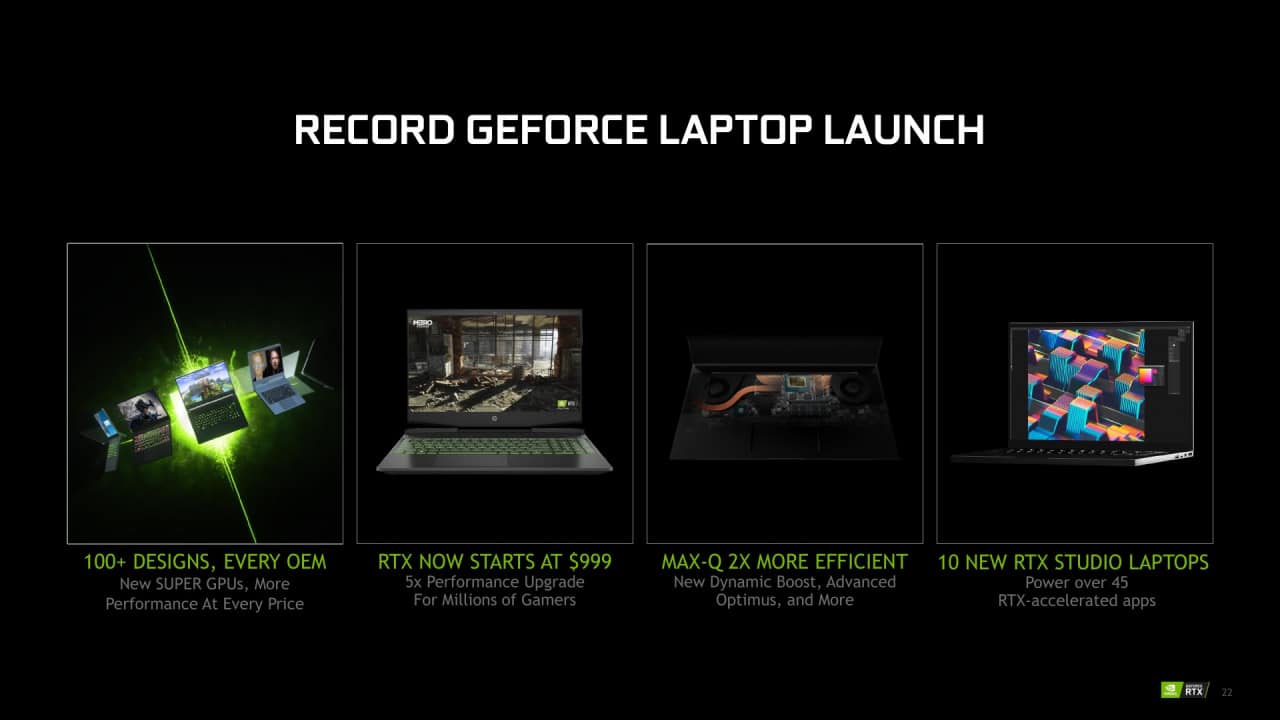Last summer, Nvidia introduced the performance-enhanced Geforce RTX Super graphics card series for desktops. Now the company’s Super rollout continues, but this time it’s instead two new models aimed at high – performance laptops.
Specifications: Nvidia Geforce RTX Super for laptops
RTX 2080 Super | RTX 2080 | RTX 2070 Super | RTX 2070 | |
|---|---|---|---|---|
Technical | 12 nm TSMC | 12 nm TSMC | 12 nm TSMC | 12 nm TSMC |
Circuit | TU104 | TU104 | TU104 | TU106 |
Architecture | Turing | Turing | Turing | Turing |
CUDA cores | 3 072 st. | 2 944 st. | 2 560 st. | 2 304 st. |
Texture units | 192 st. | 184 st. | 160 st. | 144 st. |
Raster units | 64 st. | 64 st. | 64 st. | 64 st. |
Tensor cores | 384 st. | 368 st. | 320 st. | 288 st. |
RT cores | 48 st. | 46 st. | 40 st. | 36 st. |
Clock frequency | 1 345 MHz | 1 380 MHz | 1 140 MHz | 1 215 MHz |
GPU Boost | 1 560 MHz | 1 590 MHz | 1 380 MHz | 1 455 MHz |
Memory bus | 256-bit | 256-bit | 256-bit | 256-bit |
Memory amount | 8 GB GDDR6 | 8 GB GDDR6 | 8 GB GDDR6 | 8 GB GDDR6 |
Memory frequency | 14 000 MHz | 14 000 MHz | 14 000 MHz | 14 000 MHz |
Memory bandwidth | 448 GB/s | 448 GB/s | 448 GB/s | 448 GB/s |
TDP | 150 W+ | 150 W+ | 115 W | 115 W |
* Refers to the energy-efficient Max-Q variant of the circuit
Among the news for laptops are the new variants Geforce RTX 2080 Super and RTX 2070 Super, where the former, like on the desktop side, replaces the previous model Geforce RTX 2080 straight off in the lineup. The circuits are delivered in two versions – a performance variant with a higher clock frequency and a more energy-efficient variant according to the company’s concept Max-Q.
Geforce RTX 2080 Super for laptops is based around the same TU104 circuit as for desktops with 3,072 CUDA cores. What differs is instead clock frequencies, where the performance variant has one boostfrequency of 1,560 MHz while the energy-efficient Max-Q model lands at 1,080 MHz.
On the memory front, 8 GB GDDR6 can be seen again, but the speed of this has been turned down to 14,000 MHz compared to the stationary variant’s 15,500 MHz. In terms of power budget, the model puts in its performance version of 150 W while Max-Q for slim computers lands at 80 W.
When it comes to the Geforce RTX 2070 Super in portable design, it is again the same TU104 circuit that is lifted over from the stationary side with 2,560 CUDA cores under the hood. Boostthe frequencies here are at 1,380 MHz for the performance variant, while Max-Q takes a step down to 1,315 MHz. The graphics memory consists of 8 GB GDDR6 running at 14,000 MHz.
In connection with the introduction of Geforce RTX Super for laptops, Nvidia says it has improved energy efficiency twice for the Max-Q circuits compared to the first circuits launched according to the concept in 2017. This is achieved through a combination of technologies, including scaling via DLSS, GDDR6 circuits with lower voltage and more efficient power supply.
One of the more interesting additions is what Nvidia calls “Max-Q Dynamic Boost”, which is very reminiscent of the “Smartshift” that AMD introduced with the Ryzen 4000 series for laptops. In practice, the technology allows the graphics part to borrow part of the power budget from the computer’s processor, which in GPU-bound scenarios gives the circuit the opportunity to increase the clock frequencies further.
► Higher performance with Smartshift
Furthermore, the company introduces “Advanced Optimus”, which is a further development of Nvidia’s previous technology to seamlessly switch between the processor’s integrated graphics and a dedicated graphics circuit in the computer to save battery. For the original “Optimus”, only the integrated graphics circuit was connected to the monitor, which meant that adaptive synchronization via Gsync was not possible to use.
With “Advanced Optimus”, both the processor’s graphics part and the Geforce circuit have a direct connection to the monitor, which means that the technology can be used together with G-Sync. This should in practice provide greatly improved battery life for laptops that use G-Sync, as these have previously not been able to switch to the more energy-efficient graphics circuit in the processor at lighter workloads.
With the launch of the Geforce RTX Super for laptops, Nvidia is shifting its lineup and adjusting the pricing of existing models. Geforce RTX 2080 Super replaces and enters the same price point as the outgoing Geforce RTX 2080. Furthermore, Geforce RTX 2070 Super takes a position at the same price level as Geforce RTX 2070 and pushes the latter down a notch, which should mean that the latter takes place in more affordable computers than before.
This ultimately means that the Geforce RTX 2060 will also be price-adjusted downwards and will in future be available in gaming laptops starting at $ 999 – a position previously held by the Geforce GTX 1660 Ti.
The first laptops with Geforce RTX Super are expected to be launched at the end of April, while Nvidia announces that over 100 new models with Geforce graphics under the hood will be rolled out during the rest of the year. The launch coincides with Intel’s introduction of the Comet Lake-H processor series, with which the new graphics cards will in most cases be paired.















